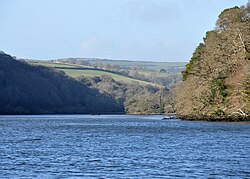St Winnow
| St Winnow Cornish: Sen Gwynnek | |
| Cornwall | |
|---|---|
 The Fowey estuary at St Winnow | |
| Location | |
| Grid reference: | SX1157 |
| Location: | 50°22’59"N, 4°39’7"W |
| Data | |
| Population: | 328 (2011) |
| Post town: | Lostwithiel |
| Postcode: | PL22 |
| Dialling code: | 01208 |
| Local Government | |
| Council: | Cornwall |
| Parliamentary constituency: |
South East Cornwall |
St Winnow is a village and parish in Cornwall, with a population of just 328 according to the 2011 census.[1]
The name of the village is from the dedication of the church and may be connected with either that of St Winnoc or St Winwaloe.
The village stands on the east bank of the River Fowey south of Lostwithiel. The river is tidal here and deep and broad at the flood, and the village has a small quay on the river.
Part of the village of Lerryn, on the tidal River Lerryn lies within the parish too.
Churches and chapels

Parish church
The parish church is of Norman foundation but the present building is almost entirely of the 15th century. The rood screen survives and there is some interesting stained glass.
The church stands at the riverside, next to a quay at the limit of navigation of the River Fowey. It is probably on the site of the 7th century oratory of St Winnoc. A stone church was built in the 12th century, probably cruciform in plan, and there are traces of the Norman stonework on the north side. The transept arch was reconstructed in the 13th century. About 1465 the south wall was demolished and the south aisle, arcade and roofs built.
The chancel was restored by J. H. Seddon in the 19th century, retaining the 16th century east window. The west tower is of standard Cornish Perpendicular style. There is stained glass of c. 1500 in the east windows of the chancel and S aisle. The 16th century rood screen, carved with leaves and flowers, was restored by Violet Pinwell in 1907 (by Edmund H. Sedding according to Pevsner). The loft, rood and some of the south aisle screen were newly made in the restoration. The granite font, carved with angels bearing shields, is 14th century. The pulpit is of c.1600 and richly carved. There are also carved bench ends of various dates from 1485 to 1630. The monuments include one in slate to William Sawle, d. 1651.
A burial plot with Celtic-style headstones for the Vivian family occupies the north-west corner of the churchyard.
Chapels
The chapel of St Nectan in the parish is of the 13th and 15th centuries but the north aisle was added in 1825. The tower has lost its upper stages due to the Civil War (1644).[2] The mediæval parish was larger and included also Boconnoc and St Bradoc: the chapels of St Nectan and St Martin's at Respryn were quasi-parochial.[3] The 14th century font from Respryn was reused at Herodsfoot.
History
St Winnow is recorded in the Domesday Book of 1086 as San Winnuc.
In 1644-45, some ninety people from the parish died of the plague, four of them soldiers but a campaign of the Civil War was going on at the time.
Ecology and wildlife
During the late 1990s Ethy Wood was found to be an interesting site for lichens, and in 2013 a species new to the West Country was found by lichenologist Neil Sanderson during a survey of the wood. Arthonia ilicinella was found on a small, slow-growing holly by the river, and is known from Ireland and Galloway. Also found was Bacidia incompta, a species which has declined along with elms affected by Dutch elm disease.[4]
The Redlake Meadows & Hoggs Moor Site of Special Scientific Interest lies within the parish.
Outside links
| ("Wikimedia Commons" has material about St Winnow) |
References
- ↑ Information on St Winnow from GENUKI
- ↑ Nikolaus Pevsner: The Buildings of England: Cornwall, 1951; 1970 Penguin Books ISBN 978-0-300-09589-0
- ↑ Cornish Church Guide (1925) Truro: Blackford; pp. 220-221
- ↑ Anon. "New discoveries". News and events for summer 2014 (Summer 2014 ed.). National Trust.
- Brown, H Miles. (1994) The Book of St Winnow. Liskeard: Artworks
